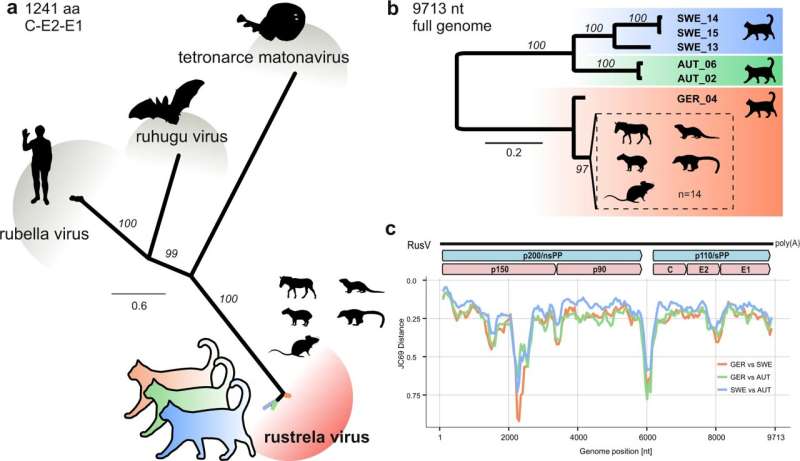Sequence comparison of complete rustrela virus (RusV) genome sequences from cats from Sweden, Austria, and Germany. a The amino acid sequences of the structural polyprotein (p110/sPP) of all known matonaviruses were aligned and a maximum-likelihood (ML) phylogenetic tree was calculated (IQ-TREE2 version 2.2.0; FLU + F + I + G4; 100,000 ultrafast bootstraps). Bootstrap support values are shown in italics. b ML tree of complete or nearly complete RusV genome sequences from cats with ‘staggering disease’ and all publicly available RusV sequences (IQ-TREE2 version 2.2.0; TIM3 + F + I; 100,000 ultrafast bootstraps). Sequences from Sweden, Austria, and Germany are highlighted in blue, green, and orange, respectively. Sequences from a previously identified German RusV cluster from zoo animals with encephalitis and apparently healthy yellow-necked field mice (Apodemus flavicollis) are presented in a dashed box. Bootstrap support values are shown at the nodes. c The genetic variability of RusV lineages from Sweden, Austria, and Germany is presented as mean pairwise JC69 distance using a sliding window analysis (window: 200 nt; step size: 50 nt). The genomic organization of RusV is shown, highlighting the non-structural (p200/nsPP) and structural (p110/sPP) polyprotein open reading frames, as well as the mature cleavage products protease (p150), RNA-directed RNA polymerase (p90), capsid protein (C), and glycoproteins E2 and E1. Credit: Nature Communications (2023). DOI: 10.1038/s41467-023-36204-w
For cats with outdoor access, feline meningoencephalomyelitis, better known as "staggering disease," is a serious and potentially fatal threat. The disease, which involves the inflammation of the brain and spinal cord in European domestic cats (Felis catus), was first described in Sweden in the 1970s and in Austria in the 1990s.
Now, some 50 years after the first discovery of the disease, a team of researchers affiliated with several institutions including the University of Veterinary Medicine Vienna, has finally been able to identify the rustrela virus, a relative of the rubella virus that infects humans, as the cause. The study is published in the journal Nature Communications.
For a long time, the rubella virus that infects humans was considered to be the only representative of the Rubivirus genus. The recent discovery of two other rubiviruses infecting animals, however, suggests that the rubella virus, like SARS-CoV-2, may have found its way to humans through a zoonotic pathway.
An international team of researchers with significant participation from the Institutes of Pathology (Herbert Weissenböck, Christiane Weissenbacher-Lang, Julia Matt) and Virology (Norbert Nowotny, Jolanta Kolodziejek, Pia Weidinger) at the University of Veterinary Medicine in Vienna, has now been able to detect one of these two rubiviruses in cats, thereby solving a scientific mystery that goes back nearly half a century. In making this discovery, the researchers from Germany, Sweden and Austria clarified the cause of staggering disease, an inflammation of the brain and spinal cord in cats that has been found in these countries.
Genetic analysis identifies rustrela virus as pathogen causing staggering disease
The rustrela virus, a relative of the human rubella virus, was found to be the cause of staggering disease. This virus, which until recently had been completely unknown, has previously been shown to be associated with cases of encephalitis in zoo animals in northern Germany.
"Using next-generation sequencing, we succeeded to completely decode the viral genomes and also found the viral signatures in tissue samples from infected cats. In addition, by using special detection methods, we were able to showthat the viruses multiplied in the nerve cells of the affected animals, which triggers the inflammatory reaction that causes the disease," says study co-author Herbert Weissenböck, head of the Institute of Pathology at Vetmeduni, describing how the researchers discovered the virus.
Danger of infection for outdoor cats
Previous studies have identified yellow-necked field mice and wood mice as possible reservoir hosts of the rustrela virus. This makes it easy for outdoor cats to become infected. Herbert Weissenböck and Norbert Nowotny have a special connection to staggering disease. Together with veterinarian Josef Zoher, they published the first description of the disease in Austria 30 years ago.
"Based on the pathological changes, it was already clear to us at that time that it must be a viral infection. However, the scientific methods were not yet sufficient to confirm this assumption and to identify the causative virus," says study co-author Norbert Nowotny from Vetmeduni's Institute of Virology.
Widespread in Sweden, no cases of disease in Austria at present
Staggering disease was first described as a disease in its own 50 years ago in Sweden, where it still occurs today. Affected cats show behavioral changes and motor disorders, which manifest themselves mainly in ataxia (impaired coordination) and other gait disturbances—hence the name "staggering disease"—and subsequently paresis and paralysis of the hind limbs.
In Austria, the disease has been detected exclusively in the Marchfeld region of Lower Austria, with a strikingly high incidence in the 1990s. After that, however, the disease became increasingly rare, and no further cases have been detected within the last ten years. The reasons for this remain unclear.
More information: Kaspar Matiasek et al, Mystery of fatal 'staggering disease' unravelled: novel rustrela virus causes severe meningoencephalomyelitis in domestic cats, Nature Communications (2023). DOI: 10.1038/s41467-023-36204-w
Journal information: Nature Communications
Provided by University of Veterinary Medicine—Vienna
























